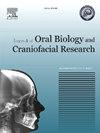天然生物材料方法:可可和芦荟在水凝胶骨再生中的协同作用:一项体外研究
Q1 Medicine
Journal of oral biology and craniofacial research
Pub Date : 2025-06-13
DOI:10.1016/j.jobcr.2025.06.009
引用次数: 0
摘要
目的确定可可和芦荟作为天然水凝胶材料的性质。原料和方法天然水凝胶包括可可豆发酵5天,磨成糊状,分离可可脂。用70%乙醇浸渍法获得芦荟提取物。样品被分成四组,浓度不同,用伽马射线消毒。测试包括使用液体置换法进行孔隙度测试,使用pH为7.4的PBS进行生物降解性测试,使用Stormer粘度计进行粘度测试,以及针对放线菌聚集菌的抗菌测试。统计分析采用单因素方差分析,显著性为p <;0.05.结果四组的水凝胶孔隙度均在理想的骨再生范围内(75% ~ 86%±0.02),差异无统计学意义。芦荟含量为12.5 mg/ml的水凝胶在第1天(65.1%±1.01)、第7天(49.56%±3.58)和第14天(77.91%±5.15)的降解率最高。芦荟含量越高,水凝胶的粘度越低。芦荟-可可水凝胶具有抗菌特性,可以抑制放线菌的生长,浓度为3.125 mg/ml起效。结论芦荟碱化可可水凝胶具有良好的孔隙度、生物降解性和黏度,可作为牙槽保存材料,防止拔牙后牙槽骨吸收。碱化芦荟可可水凝胶是一种很有前途的牙槽保存材料。该材料具有最佳的孔隙度、可控的生物降解性、合适的粘度和抗菌活性,因此可能以更经济和生物相容性的方式阻止牙槽骨吸收。本文章由计算机程序翻译,如有差异,请以英文原文为准。
Natural biomaterial approach: Synergistic effects of cocoa and aloe vera in hydrogel-based bone regeneration: An in vitro study
Objectives
To determine the characterization of cacao and aloe vera as natural hydrogel materials.
Materials and methods
Natural hydrogel includes fermentation of cacao beans for 5 days, grinding into a paste, and separating cacao butter. Aloe vera extract was obtained through the maceration method with 70 % ethanol. Samples were divided into four groups with different concentrations and sterilized using gamma radiation. Tests included a porosity test using the liquid displacement method, a biodegradability test with PBS pH 7.4, a viscosity test using a Stormer viscometer, and an antibacterial test against Aggregatibacter actinomycetemcomitans. Statistical analysis used one-way ANOVA with a significance of p < 0.05.
Results
The hydrogel porosity of the four groups was within the ideal range for bone regeneration (75–86 % ± 0.02) without significant differences. Hydrogel with aloe vera content of 12.5 mg/ml showed the highest degradation on days 1 (65.1 % ± 1.01), day 7 (49.56 % ± 3.58), and day 14 (77.91 % ± 5.15). The higher the aloe vera content, the lower the viscosity of the hydrogel. Aloe vera-cocoa hydrogel has antibacterial properties that can inhibit the growth of A. actinomycetemcomitans bacteria, with effectiveness starting from a concentration of 3.125 mg/ml.
Conclusion
Hydrogel of aloe vera – alkalized cacao demonstrates optimal porosity, biodegradability, and viscosity, which can be a candidate for socket preservation material to prevent alveolar bone resorption after tooth extraction.
Clinical significance
Alkalized aloe vera-cocoa hydrogel can be a promising alternative socket preservation material after tooth extraction. This material has optimal porosity, controlled biodegradability, suitable viscosity, and antibacterial activity, thus potentially preventing alveolar bone resorption in a more economical and biocompatible manner.
求助全文
通过发布文献求助,成功后即可免费获取论文全文。
去求助
来源期刊

Journal of oral biology and craniofacial research
Medicine-Otorhinolaryngology
CiteScore
4.90
自引率
0.00%
发文量
133
审稿时长
167 days
期刊介绍:
Journal of Oral Biology and Craniofacial Research (JOBCR)is the official journal of the Craniofacial Research Foundation (CRF). The journal aims to provide a common platform for both clinical and translational research and to promote interdisciplinary sciences in craniofacial region. JOBCR publishes content that includes diseases, injuries and defects in the head, neck, face, jaws and the hard and soft tissues of the mouth and jaws and face region; diagnosis and medical management of diseases specific to the orofacial tissues and of oral manifestations of systemic diseases; studies on identifying populations at risk of oral disease or in need of specific care, and comparing regional, environmental, social, and access similarities and differences in dental care between populations; diseases of the mouth and related structures like salivary glands, temporomandibular joints, facial muscles and perioral skin; biomedical engineering, tissue engineering and stem cells. The journal publishes reviews, commentaries, peer-reviewed original research articles, short communication, and case reports.
 求助内容:
求助内容: 应助结果提醒方式:
应助结果提醒方式:


